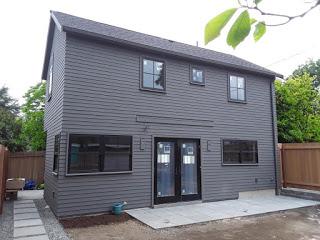This DADU was built for a grandparent in the Bryant neighborhood
Seattle City Council will hold a public hearing to discuss the proposed code changes Tuesday, June 11th at 5:30pm in council chambers. Discussion and possible vote on amendments and the proposed legislation will be held on June 28th at 2:00pm.
City council has proposed significant changes to the Seattle Land-Use Code with the aim of increasing the construction of backyard cottages (DADUs) and attached accessory dwelling units (ADUs). These changes, in the making for years now, have been delayed by a lawsuit and appeal brought about under SEPA regulations. What do these changes really mean for Seattle and for ADUs?
The proposed code changes include many items that are minor which could and should have been completed years ago. These include modest increases in size and height of allowed cottages, details about dormers, and the location of entries. The more significant changes proposed are as follows:
- Allowing two ADUs on one lot
- Removing the off-street parking requirement
- Removing the owner-occupancy requirement
- Increasing the household size limit for a lot with two ADUs
- Establishing a new limit on the maximum size of single-family dwellings equal to one half of the lot size (FAR = 0.5)
Owner Occupancy
Of these we believe the owner-occupancy requirement is most important. Currently the owner is required to live on the property for a minimum of six months of the year.
The impact to removing the occupancy requirement is unknown. The environmental impact statement (EIS) prepared as part of the lawsuit doesn't appear to adequately predict the impact from removing this requirement. Detractors believe that it will lead to the destruction of large numbers of existing homes and their replacement with duplexes and triplexes. They also note an increasing trend to sell ADUs and their primary residence separately using a condominium or land-lease agreement.
Our Recommendations:

Floor Area Ratio Limits
The EIS finds that the most significant way to reduce tear-downs (i.e the removal of naturally occurring affordable housing) will occur by introducing a floor area ratio (FAR) limit. Currently the size of new houses is limited by setbacks and height limits. The trend in new construction is for very large houses (with correspondingly large price tags), which are typically beyond the means of median income earners. The FAR limit would reduce the size of what can be built but exclude ADUs and DADUs from the restriction. The goal being to prevent tear-downs and to encourage rather the construction of ADUs and DADUs.
Our Recommendations:
The City Council will hold a public hearing to discuss these proposed changes on Tuesday, June 11th at 5:30pm in council chambers. Discussion and potential vote on the amendments and proposed legislation will be held on June 28th at 2:00pm.
We encourage you to voice your opinion with your council members and look forward to moving ahead with sensible legislation.
The impact to removing the occupancy requirement is unknown. The environmental impact statement (EIS) prepared as part of the lawsuit doesn't appear to adequately predict the impact from removing this requirement. Detractors believe that it will lead to the destruction of large numbers of existing homes and their replacement with duplexes and triplexes. They also note an increasing trend to sell ADUs and their primary residence separately using a condominium or land-lease agreement.
Our Recommendations:
- The original proposal to sunset owner occupancy after a period of time (3 years) is good and should minimize the destruction of naturally occurring affordable housing by speculative developers.
- Owner occupancy should be required for all properties used as short-term rentals.
- SDCI should closely monitor ADU construction and report annually to City Council.
The builder plans to maintain ownership of this DADU and sell the primary residence using a condominium agreement
The EIS finds that the most significant way to reduce tear-downs (i.e the removal of naturally occurring affordable housing) will occur by introducing a floor area ratio (FAR) limit. Currently the size of new houses is limited by setbacks and height limits. The trend in new construction is for very large houses (with correspondingly large price tags), which are typically beyond the means of median income earners. The FAR limit would reduce the size of what can be built but exclude ADUs and DADUs from the restriction. The goal being to prevent tear-downs and to encourage rather the construction of ADUs and DADUs.
Our Recommendations:
- Approve a FAR limit of 0.5 for new construction.
- Exemption of ADUs and DADUs from the FAR limit.
The City Council will hold a public hearing to discuss these proposed changes on Tuesday, June 11th at 5:30pm in council chambers. Discussion and potential vote on the amendments and proposed legislation will be held on June 28th at 2:00pm.
We encourage you to voice your opinion with your council members and look forward to moving ahead with sensible legislation.

No comments:
Post a Comment
have a question